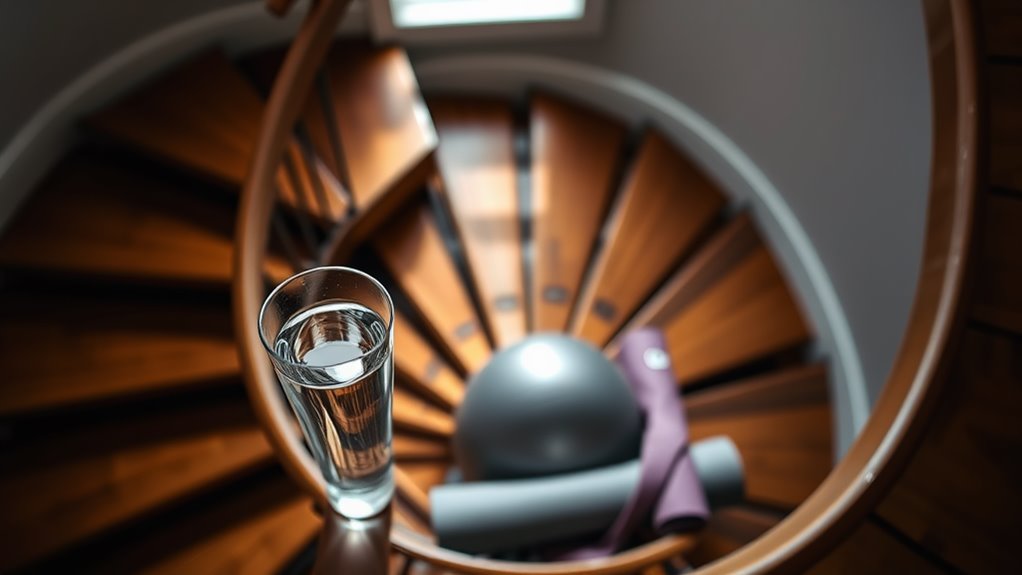Find Out What Helps Vertigo Without Medication
You can manage vertigo naturally through several proven methods. Start with the Epley maneuver, which has a 90% success rate in repositioning inner ear crystals. Stay hydrated by drinking 8-10 glasses of water daily and reduce salt intake to maintain inner ear fluid balance. Practice balance exercises like heel-to-toe walking, and create a safer home environment by installing handrails and removing trip hazards. These foundational techniques offer just the beginning of your path to better balance control.
Understanding the Root Causes of Vertigo
Understanding your vertigo’s root cause is essential before exploring vertigo relief remedies.
Your symptoms might stem from peripheral causes like BPPV, where calcium crystals in your inner ear become displaced, or Meniere’s disease, which involves fluid buildup. Peripheral vertigo is often linked to these conditions.
Central causes include strokes, tumors, or multiple sclerosis affecting your brain’s balance centers.
External factors such as stress, head injuries, or certain medications can also trigger episodes.
Additionally, lifestyle elements like poor sleep, dehydration, and environmental factors may worsen your symptoms. Staying hydrated (8-12 glasses of water daily) supports overall wellness and can help mitigate these effects.
Women experience vertigo 2 to 3 times more frequently than men, making them particularly susceptible to this debilitating condition.
Essential Home Exercises and Positioning Maneuvers
A range of effective home exercises and positioning maneuvers can provide significant relief from vertigo symptoms without medication. The Epley maneuver, with a 90% success rate, and Semont maneuver, effective in 73% of cases, are particularly powerful techniques for repositioning displaced otoliths in your inner ear. Having another person present during these exercises is recommended for safety reasons. Understanding the importance of otoliths in balance is key to using these maneuvers effectively.
| Maneuver | Success Rate |
|---|---|
| Epley | 90% |
| Semont | 73% |
| Brandt-Daroff | 50% |
You can complement these with Foster’s half-somersault technique or Brandt-Daroff exercises at home. For central vertigo issues, focus on balance exercises like heel-to-toe walking and single-leg stands to improve your postural control and reduce fall risk.
Dietary Changes That Make a Difference
If you’re struggling with vertigo, reducing your salt intake can greatly improve symptoms by helping maintain proper fluid balance in your inner ear. Additionally, a diet low in salt can support inner ear fluid balance, which is crucial for minimizing vertigo episodes. You’ll want to space your water consumption throughout the day rather than drinking large amounts at once, aiming for 8-10 glasses daily to support inner ear function and prevent dehydration-related dizziness. Studies show patients with dizziness and vertigo tend to have lower daily water intake compared to those without symptoms. For ideal hydration timing, drink water between meals and limit fluids 2 hours before bedtime to prevent nighttime disruptions while maintaining consistent inner ear fluid levels.
Salt Reduction Benefits
Reducing your salt intake can greatly improve vertigo symptoms, particularly for those with Ménière’s disease.
When you limit sodium to 1,500-2,000mg daily, you’ll likely experience fewer and less severe vertigo attacks.
Salt restriction works by lowering endolymphatic fluid pressure in your inner ear, which helps stabilize your balance system.
Research shows combining salt reduction with adequate water intake of 35ml per kg of body weight daily maximizes benefits.
This dietary change can also improve related symptoms like tinnitus and hearing problems.
To effectively cut sodium, eliminate processed foods, choose fresh ingredients, and avoid adding table salt.
Reading food labels carefully will help you track your intake.
You’ll get the best results by making these changes gradually and maintaining them long-term.
Hydration Timing Guidelines
While managing your salt intake plays a key role in vertigo control, proper hydration timing can greatly enhance your symptoms.
Start your day with a glass of water to kickstart your hydration, and maintain a consistent intake throughout your waking hours. Proper hydration helps prevent low blood pressure that can trigger dizziness.
You’ll want to focus on drinking water with meals to aid digestion and prevent dehydration.
Don’t forget to hydrate before bedtime to minimize nighttime dizziness.
If you’re exercising or engaging in physical activities, increase your water consumption to compensate for fluid loss.
These simple timing adjustments can substantially improve your vertigo management.
Creating a Safe Environment for Recovery
You’ll want to focus on creating clear walking paths throughout your home by removing obstacles and making sure of adequate lighting in hallways and stairwells. Additionally, maintaining a safe environment can help you feel more secure during vertigo episodes.
If you need support during a vertigo episode, you can contact 24/7 helpline assistance through SAMHSA’s national helpline service.
Secure your furniture against walls and make sure heavy items won’t tip over if you need to grab them for support during a vertigo episode. Consider that BPPV, the most common cause of vertigo, occurs when tiny calcium crystals in the inner ear become dislodged, leading to dizziness.
Install non-slip mats in bathrooms and high-traffic areas, and consider removing throw rugs that could cause you to trip or slip when experiencing dizziness.
Clear Pathways and Lighting
A well-designed home environment plays an essential role in managing vertigo symptoms and preventing falls.
You’ll want to establish clear pathways throughout your home by removing clutter, throw rugs, and any obstacles that could cause tripping.
Install proper lighting with evenly distributed, glare-free illumination to help your brain process visual information accurately.
Consider using nightlights in bathrooms and hallways, and keep flashlights nearby for nighttime episodes.
If you’re light-sensitive, opt for warm, natural bulbs and avoid fluorescent lighting that might trigger symptoms.
Remember to promptly replace burnt-out bulbs to maintain consistent visibility.
Installing sturdy handrails in bathrooms and along staircases provides crucial support during vertigo episodes.
Secure Furniture Placement
The strategic placement of furniture can greatly impact safety and mobility for those experiencing vertigo.
You’ll want to arrange your home’s furnishings to provide stability and support during unexpected episodes while maintaining clear pathways for safe movement.
- Position chairs and sofas near walls or sturdy tables to offer support when standing
- Keep beds against walls with accessible nightstands for nighttime stability
- Remove bulky furniture from walkways, especially in bedroom and bathroom routes
- Anchor heavy furniture like bookcases to walls to prevent tipping
- Create open spaces in living areas for safe navigation during vertigo episodes
Non-Slip Floor Protection
Safety starts with secure flooring when managing vertigo symptoms at home.
You’ll need to focus on creating non-slip surfaces throughout your living space to prevent falls and accidents.
Start by applying non-slip coatings to your floors, particularly in high-risk areas like bathrooms and kitchens.
Place non-slip mats in wet areas and near entrances.
If you have hardwood or tile floors, consider using specialized non-skid treatments to enhance traction.
Remove or securely tape down any loose rugs that could cause tripping.
When selecting new flooring materials, opt for textured surfaces that provide natural grip and stability while you navigate your home.
Natural Therapies and Alternative Treatments
Many patients seeking relief from vertigo can benefit from natural therapies and alternative treatments that don’t require medication.
You’ll find several evidence-based options, from repositioning maneuvers like Epley and Semont that show a 95% success rate, to complementary approaches like acupressure.
Vitamin D supplementation can help, especially if you’re deficient, while proper hydration and herbal remedies may reduce symptoms.
- Practice the Epley maneuver under guidance to reposition inner ear crystals.
- Apply gentle pressure to specific acupressure points on your wrists and neck.
- Get adequate sunlight exposure to boost vitamin D levels naturally.
- Sip ginger tea to combat vertigo-related nausea.
- Stay well-hydrated to maintain proper inner ear fluid balance.
Additionally, incorporating balance exercises into your routine can improve stability and reduce the frequency of vertigo episodes.
Lifestyle Modifications for Better Balance
Beyond natural remedies, making targeted lifestyle changes can greatly improve your balance and reduce vertigo symptoms.
Start by modifying your diet – maintain regular meals, increase water intake, and limit salt, caffeine, and alcohol.
You’ll also want to boost your Vitamin D consumption.
Stay active through gentle exercises like walking or yoga, but avoid sudden head movements.
Practice stress management techniques, as anxiety can worsen vertigo.
Break up long periods of sitting with brief movement sessions.
Create a safer environment by removing trip hazards and improving lighting.
If needed, don’t hesitate to use mobility aids for added stability. Additionally, incorporating the 4-7-8 breathing method can help promote relaxation and reduce anxiety, which may alleviate vertigo symptoms.
Tracking Your Progress and Treatment Success
Tracking your vertigo recovery effectively requires both systematic monitoring and the right assessment tools.
You’ll want to maintain a symptom diary documenting frequency and severity of episodes, while your healthcare provider uses standardized tests to measure your progress.
Regular follow-ups, initially weekly or biweekly, help adjust your treatment plan based on your response.
- Recording daily symptoms in a detailed diary, noting triggers and duration
- Using balance-tracking apps or wearable devices to monitor stability
- Completing quality-of-life questionnaires to assess functional improvements
- Participating in regular balance assessments with your therapist
- Documenting your ability to perform daily activities without dizziness
Additionally, understanding the connection between RLS symptoms and sleep disruption can aid in recognizing patterns that may influence your vertigo.
References
- https://www.healthline.com/health/home-remedies-for-vertigo
- https://www.webmd.com/brain/home-remedies-vertigo
- https://www.everydayhealth.com/home-remedies-alternative-treatments-vertigo/
- https://www.youtube.com/watch?v=4CaQV2TRNW8
- https://www.hopkinsmedicine.org/health/treatment-tests-and-therapies/home-epley-maneuver
- https://www.ncbi.nlm.nih.gov/books/NBK482356/
- https://medlineplus.gov/ency/article/001432.htm
- https://my.clevelandclinic.org/health/symptoms/21769-vertigo
- https://www.ama-assn.org/delivering-care/public-health/what-doctors-wish-patients-knew-about-vertigo
- https://www.webmd.com/brain/vertigo-symptoms-causes-treatment







